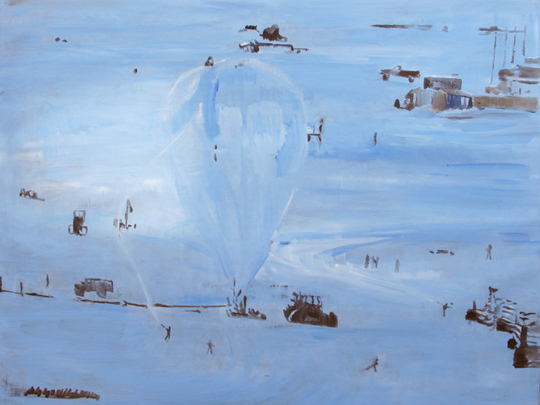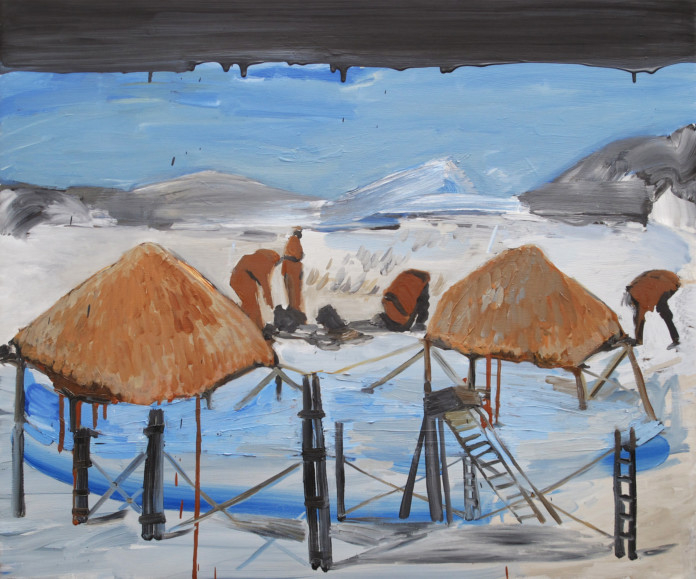
UK-based Armenian-Lebanese artist Talar Aghbashian was born in Beirut and has travelled to Syria many times. But four years ago, on a trip to Syria she visited Palmyra for the first time. That trip affected her so deeply that she began paintings eerie desert landscapes and other rough terrains, devoid of people.
Her first solo show in Dubai, “Site/Sight” also features oil paintings of arid desert landscapes and the icy terrain of the Arctic and Antarctic regions. However, for the first time, she has included people in her paintings. The human beings seem to be busy doing important work, but their tiny, almost abstracted forms look quite insignificant in the vast, empty landscapes.
The hauntingly beautiful artworks allude to the endless cycle of finding, fixing, destroying and then searching again for something to repair and eventually destroy that human beings are constantly engaged in. The desolate landscapes and the busy people involved in futile activity make a profound statement about the present socio-political scenario, especially in the Middle East.
Aghbashian’s paintings are based on photographs she has taken during her travels to empty, arid places or found on the internet, as well as stills taken from documentary films about scientific expeditions to the North and South Poles. She likes to highlight the contrast between the organic elements of the hostile terrain and the geometric shapes of the tents, vehicles, scientific instruments and exploration equipment.
In many paintings she adds elements, such as ropes, pipes and electrical cables, as evidence of human presence. One gets a sense that the people are very busy doing something significant, and that something has happened or is about to happen, but there is also an overwhelming feeling of the landscape and people being unreal.
“Taken literally, the sandy and icy terrains in my brown and blue paintings represent the disappearing deserts and ice covered regions of our planet. But for me these are symbols of a lost land that cannot be found or reached. As a third generation Lebanese Armenian, I have to accept that the historical Armenia does not exist anymore,” Aghbashian says.
“The Armenian genocide happened in the desert, and later a monument was built from the bones found there, but that has also disappeared in the sand again. Human beings have a short memory, and this is evident from what is happening in this region at present. My paintings are a reminder of a forgotten past and of the fact that though that history may be forgotten by most people — even today there are people who continue to live with the consequences of what happened.
“The people in my paintings are evidence of what once existed, and of the layers of catastrophe lying buried beneath the surface. These people are not real. Perhaps they exist only in the mind as tools that are trying to dig, explore, excavate and understand what happened. Or they are toy soldiers, hoping to find a solution.
“But this is all just wishful thinking and a Utopian dream, because their efforts are insignificant and doomed to lead nowhere in this endless cycle of destruction and reconstruction,” she says.
Jyoti Kalsi is an arts enthusiast based in Dubai.
“Site/Sight” will run at Carbon 12, Al Quoz, until June 30.
Safina Radio Project
The Safina Radio Project, launched by Alserkal Avenue during the opening week of the 56th Venice Biennale, is an initiative that links the UAE’s art scene with the global art world in a unique way. Curated by Anabelle de Gersigny, the project featured a boat that was transformed into a recording studio.
From May 6 to May 8, the boat navigated the waterways of Venice, transporting passengers from one point to another. But during their journey, the passengers were invited to participate in conversations and discussions with artists, curators and collectors on a variety of subjects. These exchanges were recorded and the podcasts were uploaded to safinaradioproject.org, creating an interesting archive of conversations and experiences.
Many of the recordings were curated interviews and conversations with artists who had been specially invited to discuss their practices. But all visitors to the Biennale who wished to participate could come aboard by registering online. The topics discussed included movement and displacement of people, notions of Utopia, trade, surveillance and collective ideas about the future.
The project’s portal also features specially commissioned content, such as interviews, audio projects, playlists and sets created by well-known musicians and sound artists.
Invited participants included New Delhi-based Raqs Media Collective; John Akomfrah, British artist, writer and filmmaker of Ghanian origin whose work focuses on the African diaspora in Europe; British artist Robin Rimbaud (known as Scanner) whose work combines sound, space, image and form, and pioneering Emirati artist Hassan Sharif, whose work is being exhibited at the Biennale. Online contributors included MENASA music specialist Neil van der Linden; UAE-based Analog Room and Kamal Rasool, whose compositions combine African, Asian and Middle Eastern influences.
“Safina in Arabic means vessel or ship, with literary roots in reference to Noah’s Ark. We chose this name because the Safina Radio Project represents a vessel as an incubator for experimental and progressive approaches. Visitors to the Venice Biennale do spend a lot of time on boats, and many interesting encounters and conversations happen during these journeys. So we responded to the way the city functions,” de Gersigny says. “With each journey the project created transitory and transient communities focusing on collective experience and investigating how we locate ourselves and how we mediate our human and historic commonality. We wanted to create a platform for a multiplicity of access points and possible audience engagement broadening the conversations and widening interactions, from playful through to more critical discourse,” de Gersigny says.
Tairone Bastien, programming director for Alserkal Avenue, says, “Alserkal Avenue is expanding this year, and our homegrown programme is also growing. Our aim is to support the local arts ecosystem by incubating new ideas by artists, curators and programmers that add to the cultural landscape of the region. We also want to provide a springboard for homegrown talent to take their ideas to the international art community.”
“The Safina Radio Project has given artists from the UAE a chance to have their voice heard at one of the most important art events in the world, and allowed us to explore this platform and the possibility of developing a cultural radio project that will broadcast from Alserkal Avenue in the future.”
–Jyoti Kalsi
The podcasts from the boat and other content is available on safinaradioproject.org













